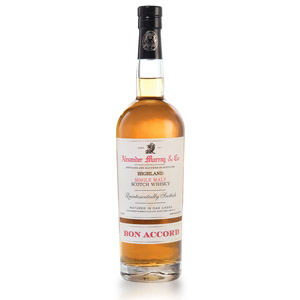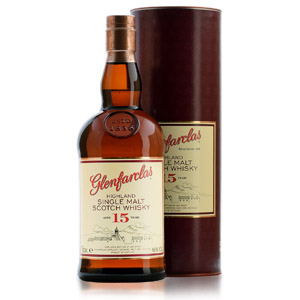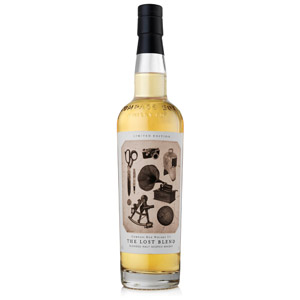I can’t get enough of heavily sherried single malt scotches, colloquially known as “sherry bombs”. I was in favor of Glengoyne’s 12 year-old bottling, although it didn’t quite qualify in the “bomb” category, so I was interested to see how the producer’s NAS Cask Strength release compares to similar heavy-hitters like Aberlour A’Bunadh and Glenfarclas 105. As usual with big corporate spirits websites, Glengoyne’s is gorgeous but provides exactly no useful information about the making of this dram. That ever-flowing font of questionably-sourced information, The Internet, reveals that this release replaces an earlier 12 year-old cask strength edition, which is a sad but oft-repeated refrain in today’s insane whisky market. One can thus deduce that the average age of this bottling hovers somewhere between 9 and 12. Some equally unsubstantiated information suggests that this batch was aged exclusively in first- and second-fill sherry casks.
Glengoyne’s whisky is distilled from Golden Promise barley, a low-yield heritage strain of barley used rarely in today’s big-volume whisky industry (The Macallan is also known for using the strain). Glengoyne is also notable for the speed of its distillation (purportedly the “slowest” in Scotland), its total lack of peat even in the process water, and its location very near or perhaps on top of the invisible line dividing the Highlands and the Lowlands of Scotland. The Cask Strength batches are bottled without added coloring and without chill-filtration. I tasted a sample from Batch #4.
For reviews of the non-cask-strength editions, see Glengoyne 10 and Glengoyne 12.
For an interesting meta-analysis of batch variability, see selfbuilt’s Whisky Analysis of this Glengoyne.
Nose: Sherry bomb. Unlike Glenfarclas 105, this sherry is more resinous and jammy, with blackberry, blackcurrant, and fig notes, reminiscent of the house style of GlenDronach. There is also a deep caramel note.
Palate: Thin body. The sherry translates directly to the tongue, with the same berry notes. After an intense fiery tongue burn, notes of dark chocolate, fig, and browned pie crust dominate.
Finish: Medium-long. Here the fruit notes are more dried, specifically dried cherries. The chocolate remains, which is a nice combination, and both remain long enough to convey a chocolate-covered cherry coincidence. A little bitterness invades as the rest fades.
With Water: A few drops of water add a tinge of vanilla to the nose, and seem to improve the body. The dark chocolate notes become a little closer to milk chocolate, for what that’s worth. I recommend a little water with this, especially at a whopping 58.8% ABV.
Overall: A pleasant but fiery dram worthy of both the names Glengoyne and Cask Strength. Like Aberlour A’Bunadh, this delivers both sherry and alcohol in a one-two punch. Between the two, I prefer the Aberlour’s fresher fruits. Still, when A’Bunadh reaches the $100-ish mark later this year, you might still be able to find Glengoyne’s cask strength batches in the $60 to $80 range, which would make it the new king of value when it comes to cask-strength sherry bombs. This is especially true when compared to the other “value” choice in cask-strength sherry bombs, Glenfarclas 105, which I think shrivels in comparison to this. With those chocolate notes, I could see this alternating with A’Bunadh for the cask-strength sherried spot in anyone’s cabinet.










If the age “information” here is unsubstantiated, why is it given credence? If it isn’t being given credence, why is it included? Better yet, if, as per NAS, age doesn’t really matter to the finished product if and when the industry says it doesn’t, why is there a need to “deduce” (a.k.a. “make up”) said age information at all? Why are people guessing at information if they don’t really think, or don’t know, it matters in the first place? Just wonderin’.
Cheers!
Simply, because I’d rather say “I’ve heard it’s X years old” than “I don’t have exact documented proof of its age”. This is a blog, not a scientific journal.
Oh, so you’d rather say “I’ve heard it’s X years old” – with no real reason TO think it’s X years old – then say “I don’t have exact documented proof of its age” even though the latter is more accurate. I don’t put it entirely on your shoulders by any means, but you realize this is one of the reasons that “the Internet”, at large, isn’t really a source of information – forget “a scientific journal” – any more: people just do “what they’d rather” instead of caring about facts. If it helps, you can now safely say that “all this NAS-centered ‘deduction’ is really nothing more than bullshit” – because you just “heard it” from me.
The same folks who would guess about age would probably be willing to guess about ABV too – which is why I’m glad that ABV information is in law, so I don’t need anybody’s guesses.
We disagree on this, but it’s still a really good blog.
Cheers!
Well that is why I would be in favor for the push from several distillers (lead by Bruichladich and Compass Box) and to be allowed to share specific information about the specific casks they use in a specific bottle rather than just the age of the youngest scotch that we find in it. Such transparency would really be helpful and allow distiller who use a well crafted blend of the right young spirits and old spirits to shine (I don’t care if they use a decent 6 years old spirit if it is carefully balanced with a 20 years old for instance).
I’d be in favour of any scenario in which:
– more production information was being shared with the people actually buying the product;
– less “information” was simply made up, usually as a result of trying to fill the informational vacuum left by producers.
Truth be told, I’m a little disappointed with Compass Box; despite all the talk about transparency and a legal way, upon request, to provide consumers with information, Compass Box doesn’t provide age info on all of its releases.
My understanding from the email on Compass Box is that they will tell you the age and components of any of their releases, if you email or call them. They just ask that you not share that info online, for legal reasons. Have they refused to tell you the age of something?
Noob, where did you hear that age info?
Or how did you deduce that the age is between 9 and 12?
Somewhere between deduction and a WAG (that’s “wild-ass guess”). Specifically, Glengoyne’s only cask-strength official bottling was a 12 year-old until recently, when they discontinued it for this NAS version. Since it’s approximately the same price, and since many (most?) whisky producers are using NAS as a way to stretch slightly younger stock, it’s a reasonable assumption that the Batch 4 is both younger than 12 years (otherwise they would use the previous age statement) and not too much younger. Of course I could be wildly wrong and it could be 5 years old, but I doubt it, based on the tasting.
Fair question – this is my email to CB and their response:
Hello to all at Compass Box!
I’ve noticed that there is no way to request age information on many of your Limited Edition Expressions – Enlightenment, This Is Not A Luxury Whisky. Flaming Heart, Hedonism Quindecimus, Orangerie, The Circus – and was wondering if this was going to be corrected on the website.
Thanks,
Jeff
—-
Hi Jeff
Thanks for getting in touch!
You’ll be able to request component age information by following the “Request Age Info” button found on the lower right hand side of the product pages on our website – http://www.compassboxwhisky.com/whiskies/index.php?id=18 – for all of our permanent range whiskies and the most recent Limited Editions. This is also something that we aim to continue moving forward.
Unfortunately, this isn’t feasibly something that we can offer on all past Limited Edition whiskies. We’ve made quite a few whiskies over our 16 years and at the time of producing them we did not envisage a future situation where we would be able to share such detailed information!
Thanks very much for your support of our whiskies and our Transparency campaign!
No idea, and no explanation as to why the above is, particularly given that many of these whiskies aren’t from 16 years ago – somebody lost the recipes? Sorry, I just don’t believe it.
Fair enough. Thanks for pasting the email exchange. That is a disappointment, there’s no good reason for them to reveal some of the expressions and not all of them.
Yeah, I just don’t see the reason for it; it can’t be that the information no longer exists. CB still has something to hide that’s… only known to CB.
I’ve never quite understood why certain people get in such a huff about NAS. As a consumer, I prefer more information to less. When I have more information, I am more likely to buy the product.
When I am considering purchase of a bottle or dram of whisk(e)y, I prefer to have access to the following facts, to allow me to make an informed decision.
1. The distiller. This is always available with exception of certain IBs that say “Speyside region” or equivalent, for reasons I don’t quite understand. I don’t buy those IBs.
2. Region. Easily inferred from the distiller and by doing a little research. It’s not just the region of Scotland that matters. If the liquid was aged in India or the US, we know it ages much faster due to the variable climate relative to temperate Scotland/Ireland. (This presents a notable competitive advantage that I believe will re-shape the industry in the years ahead.)
3. Age. Do I prefer age statements to NAS? Absolutely, but it’s just one piece of the puzzle (see #5).
4. Type of cask. Sherry vs bourbon vs new oak. This is usually disclosed.
5. How many fills. A first fill barrel will influence the juice much faster than a 3rd fill barrel. This fact is just as important, possibly more important, than the years in the cask. When first fill, this information is sometimes shown on the bottle/box/canister, which greatly increases the probability of my buying it. We know that Lagavulin and Oban use refill casks, for example, but we only know that through research.
Punchline: I have no problem with NAS if I can check many of the other important boxes above. It is not the be all end all that some individuals (names withheld) seem to believe it is.
Thanks for the analysis, DJ, I agree with everything you said. Cheers!
DJ, on point #1, I bet you’re missing out on some great malts. The reasons are often legit (i.e., not hiding some shady practices). The topic happens to have come up just today on WhiskyWhiskyWhisky:
http://www.whiskywhiskywhisky.com/forum/viewtopic.php?f=268&t=9594&sid=32b658354366212280d4aee925e63a50
And Serge happens to have reviewed some just today too!
http://whiskyfun.com/#200417
Sure, DJ, age is “only piece of the puzzle”, but it, evidently is a very important piece; it’s the reason that producers are willing to store casks for decades and lose considerable amounts to Angel’s Share in the bargain. Anybody who tells you that they can make age “irrelevant” by simply ignoring and/or withholding the information is a transparent liar – and I question the skill and/or veracity of ANY “whisky expert” who won’t tell you as much; they’re all selling something.
Thanks for the link to my commentary on this Nathan! I should update that page now, since I do have enough scores on batch 4 to publish in the database.
Certainly agree with your relative ranking relative to a’bunadh and glenfarclas 105, and your reasoning (i.e, this is a more jammy/pie-filling type of fruit, compared to the fresher ones on a’bunadh). The baked goods feeling here is particularly strong to me, with that heavy brown sugar note (this was the first time demerara occurred to me, and I was surprised to see it in the official tasting notes that I checked afterwards).
Cheers!
Ol’ Jas: very helpful link (and timely!) although I can’t say purchasing a bottle in which the distiller is not disclosed carries much appeal to me personally. Maybe I’m just too risk averse. I would think the buyer REALLY has to trust the IBottler to take such a flyer.
Side question for the SN world that popped into my head when crafting my early note: If Oban uses exclusively 2nd fill casks, where do they get them? If from a range of sources, each cask would have previously held a scotch whisky, but a different scotch whisky, which presumably would have a notable influence on the Oban juice that emerges at the conclusion of the 2nd fill.
I don’t know the answer to this. Often ex-bourbon casks that are rebuilt into hogsheads are ‘seasoned’ with grain whisky for 3-5 years to blunt the effect of new oak heads necessary for the larger casks. Perhaps Oban sources these? It’s also possible that, being a Diageo plant, they have access to a consistent flow of once-used casks from other Diageo distilleries… I just don’t know.
I will have to try this one. I really like the 12yr old.
Hey SN, what is your preference between Glengoyne Cask Strength and the 15yr?
Never tried the 15. Typically (these days), I tend to prefer well-proofed age-stated official bottlings over the official Cask Strength releases. Someone seems to have told distilleries that CS has a cachet about it, and they charge enthusiastic premiums when it really should just be 50% more (MAX). Glengoyne CS is reasonably priced, but NAS. I’d probably choose the 15, untasted, if they’re the same cost. The 17 was lovely, but expensive.